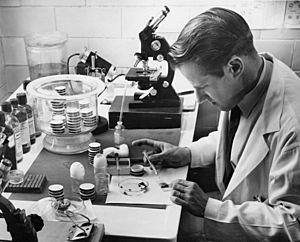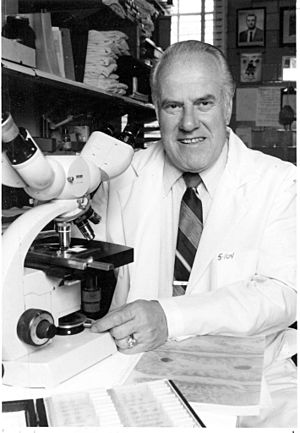Willy Burgdorfer facts for kids
Quick facts for kids
Willy Burgdorfer
|
|
|---|---|

Willy Burgdorfer inoculating Ornithodoros ticks, 1954.
|
|
| Born | June 27, 1925 Basel, Switzerland
|
| Died | November 17, 2014 (aged 89) |
| Alma mater | University of Basel |
| Known for | Borrelia burgdorferi |
| Scientific career | |
| Fields | Entomology |
| Thesis | Analyse des Infektionsverlaufes bei Ornithodorus moubata (Murray) und der natürlichen Übertragung von Spirochaeta duttoni' (1951) |
Willy Burgdorfer (born June 27, 1925 – died November 17, 2014) was an American scientist. He was born and studied in Basel, Switzerland. He became a world leader in studying insects and how they spread diseases. This field is called medical entomology.
He is famous for finding the tiny germ (a bacterium) that causes Lyme disease. This germ is a type of spiral-shaped bacteria called a spirochete. It was named Borrelia burgdorferi after him.
Contents
Early Life and Education
Willy Burgdorfer was born on June 27, 1925, in Basel, Switzerland. He went to the University of Basel. There, he earned his Ph.D. This is a high-level university degree. He studied zoology (animals), parasitology (parasites), and bacteriology (bacteria). He also studied at the Swiss Tropical and Public Health Institute.
For his Ph.D. project, he studied a specific type of spirochete. This spirochete causes a disease called African relapsing fever. He looked at how this germ, Borrelia duttonii, grew inside a tick. The tick was called Ornithodoros moubata. He also checked how well the tick could pass the germ to animals when it bit them.
While in college, he was part of a research team. They investigated outbreaks of Q fever in Switzerland. This work made him interested in similar research. This research was happening at the Rocky Mountain Laboratories (RML). RML is a research center in Hamilton, Montana, in the U.S..
In 1952, he joined RML as a research fellow. Later, he became a research associate. This was part of the U.S. Public Health Service program. In 1957, he became a U.S. citizen. Soon after, he joined the RML staff as a medical entomologist.
Discoveries and Research
Dr. Burgdorfer's research focused on how germs spread. He studied how disease agents from animals and humans interact. He looked at how these germs are carried by arthropods. Arthropods are creatures like ticks, fleas, and mosquitoes. These carriers are called vectors.
He published over 225 papers and books. His work covered many diseases. These included relapsing fevers, plague, tularemia, and Rocky Mountain spotted fever. He also studied Colorado tick fever and other bacterial and viral diseases.
Dr. Burgdorfer became famous worldwide in 1982. He discovered that a spirochete carried by ticks caused Lyme disease. This was a big breakthrough. Scientists had been looking for the cause of Lyme disease for a long time. The germ was named Borrelia burgdorferi in his honor.
Throughout his career, he worked with many health groups. He participated in seminars and meetings. These included events organized by the World Health Organization (WHO).
From 1967 to 1972, he was part of the Rickettsial Commission. This group advised the Armed Forces Epidemiology Board. For several years, he also helped lead a research project. This project studied diseases spread by ticks in Egypt. From 1979 to 1986, he directed a WHO center. This center focused on rickettsial diseases at RML in Montana, U.S..
Dr. Burgdorfer believed that Borrelia burgdorferi caused a lasting infection. He thought that the current tests for Lyme disease needed to be completely redone. He felt that new tests should be developed without knowing the expected results.
Later Life and Legacy
Dr. Burgdorfer retired in 1986. However, he continued to work with RML. He was a scientist emeritus in their lab. He also served on the Scientific/Medical Advisory Committee. This committee was part of the Lyme Disease Foundation.
In 1999, he gave a special speech. This was at the 12th International Conference on Lyme Disease. He passed away on November 17, 2014. He died from problems related to Parkinson's disease in Hamilton, Montana.
Awards and Recognition
Dr. Burgdorfer received many honors for his important work:
- Schaudinn-Hoffman Plaque (1985, German Society of Dermatologists)
- Robert Koch Gold Medal (1988, Berlin, Germany)
- Bristol Award (1989, Infectious Diseases Society of America)
- Walter Reed Medal (1990, American Society of Tropical Medicine and Hygiene)
- Doctor Medicina Honoris Causa (1986, University of Bern, Switzerland; 1991, University of Marseille, France)
- Honorary Degrees of Science (1990, Montana State University; 1994, Ohio State University)
Images for kids




